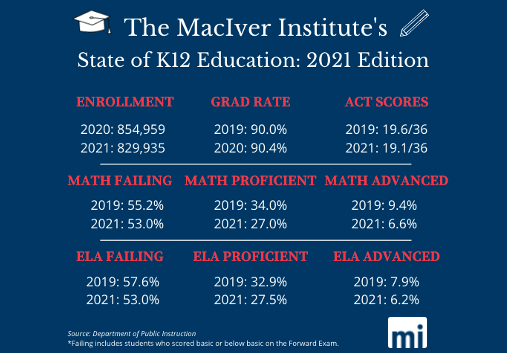
November 1, 2021
By Abbi Debelack
The latest data on testing and proficiency rates for Wisconsin’s children were recently released by the Department of Public Instruction and it is not pretty. Yet despite the alarmingly low test scores, there appears to be little to no outrage by the media and education establishment.
Each year, Wisconsin students, in various grades, take a series of standardized tests to assess their proficiency in a range of different subjects. Test results are a useful tool to track a student’s academic progress and gauge the overall effectiveness of Wisconsin’s K12 education system. The Forward Exam is given to students in grades three through eight and ten. The ACT Aspire test is given in grades nine and ten. The ACT writing test is given in grade eleven and the Dynamic Learning Maps is given to students with cognitive disabilities. This year, the tests were administered to students in the spring. The tests were not administered in 2020 because of COVID-19.
 This year, English Language Arts (ELA) proficiency is 27.5%, down 5.4 points or a 16.41% reduction from 2019. Math proficiency is at 27%, down 7 points from 2019 or a 20.59% reduction. These figures look at proficiency rates as a percentage of TOTAL Wisconsin students, not just those tested as Superintendent Underly reported in her press release.
This year, English Language Arts (ELA) proficiency is 27.5%, down 5.4 points or a 16.41% reduction from 2019. Math proficiency is at 27%, down 7 points from 2019 or a 20.59% reduction. These figures look at proficiency rates as a percentage of TOTAL Wisconsin students, not just those tested as Superintendent Underly reported in her press release.
We must point out that this is not a particularly difficult or rigorous grading metric. A student who is graded as being proficient on the Forward Exam means the child is operating at grade level. Let that sink in. Shockingly, less than one-third of Wisconsin students are proficient in math or English Language Arts.
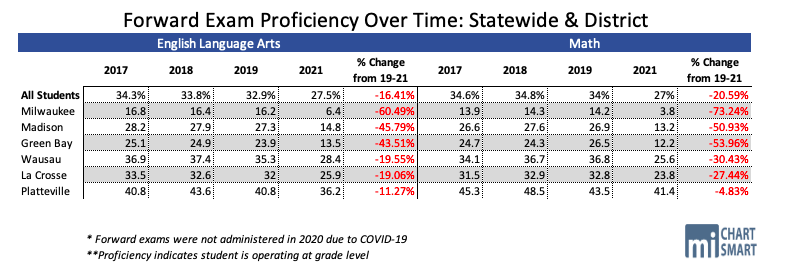
What is even more alarming than the fact that less than a third of our students are not proficient in math or English, is the percentage of our students that score BELOW the proficient line, at the “basic” or “below basic” levels.
According to the DPI website, a student who earns a basic rating on the Forward Exam “demonstrates some academic knowledge and skills tested on the statewide standardized test.” A student who earns a below basic rating on the Forward Exam “demonstrates little academic knowledge and skills tested on the statewide standardized test.”
In 2021, 53% of students who took the Forward Exam earned a basic or below basic designation in ELA and/or math. Fifty-three percent!
In Wisconsin, we have over 50% of our students between grades 3-10 who FAIL this important benchmark.
Think about that for a second. Where is the outrage?
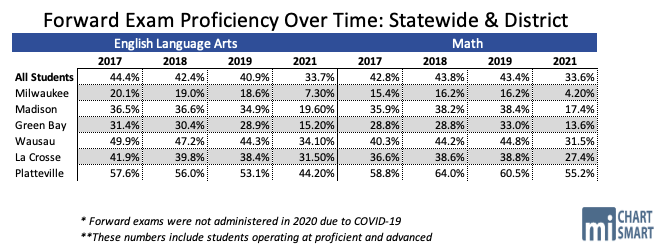
In addition to the students who are proficient — operating at grade level — a small percentage of Wisconsin students tested advanced on the Forward Exam. In 2021, 6.2% of all students were proficient in ELA, down from 7.9% in 2019. Math saw a bigger dip in the advanced category, with 6.6% of students testing advanced in 2021, down from 9.4% in 2019.
We also saw an increase in the achievement gap between black and white students from 2019 to 2021. In 2019, 10.5% of black students across the state were proficient in math compared to 40.1% of their white classmates — a 29.6 point difference. In 2021, 4.1% of black students tested proficient in math compared to 33.9% of their white classmates — a 29.8 point difference.
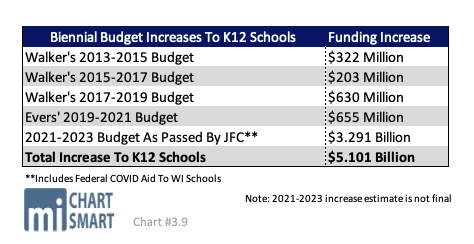
ELA saw similar trends with 11.6% of black students proficient compared to 38.5% of white students in 2019, a 26.9 point difference. In 2021, 6.6% of black students were proficient in ELA compared to 33.4% of their white classmates, a 26.8 point difference.
Every ethnicity group listed on DPI’s dashboard experienced a decrease in proficiency rates from 2019 to 2021. This trend is nothing new. The MacIver Institute has been reporting on this for years.
Almost as concerning as the number of children who are operating at a failing or proficiency level is the high number of students who did not take the test this year. According to DPI, approximately 487,000 students, or only about 84% of Wisconsin’s 580,000 students took the math and ELA exams. In past years, according to DPI, participation was generally above 95%.
Given that such a large percentage of students did not take the exam this past year, it is quite possible that the proficiency levels are even lower than reported here.
For context, we have approximately 830,000 K12 students enrolled in public schools this year and 120,000 in private schools.
Some of the state’s largest districts had alarmingly high rates of students who did not take the Forward Exam. In Milwaukee Public Schools (MPS), 56% of students did not take the ELA test in 2021, compared to 1.5% who did not take the same test in 2019. Madison Schools saw a similar trend with 50% of students not taking the ELA test in 2021, compared to 4.7% in 2019. Other large districts had slightly better turnout with only 8.2% of students in La Crosse, 8.6% of students in Wausau, 18.1% of students in Racine, and 26.2% of students in Green Bay not completing the ELA test in 2021. 
Given that such a large percentage of students did not take the exam this past year, it is quite possible that the proficiency levels are even lower than reported here.
When reporting the proficiency scores in her press release, Dr. Underly omitted the students who did not test as they “count against overall proficiency scores,” explaining that “students did not participate in the assessments in some instances due to local health conditions and concerns, or to parent choices to keep students home.”
In the past, the MacIver Institute would not factor out students who were not tested, as the percentage had tended to be very low in prior years. Given the large increase of students not taking the test this year, we will note that of students tested — roughly 86% of the total student population –32% were proficient in ELA and 31% were proficient in math, as reported by Dr. Underly.
This lack of testing and increase in virtual learning over the past few years has hit some of the state’s largest schools the hardest. Unfortunately, Milwaukee Public Schools had some of the most substantial declines in proficiency scores across the state. In 2018-2019, 16.2% of MPS students were proficient in ELA, and 14.2% were proficient in math. These numbers fell even further in 2020-2021. Only 6.4% of students were proficient in ELA, a 60.5% decrease from 2018-2019. Math was even worse with only 3.7% of students proficient, a 73.24% decrease from 2018-2019. 56% of Milwaukee students did not take the Forward exam in the 2020-2021 school year.
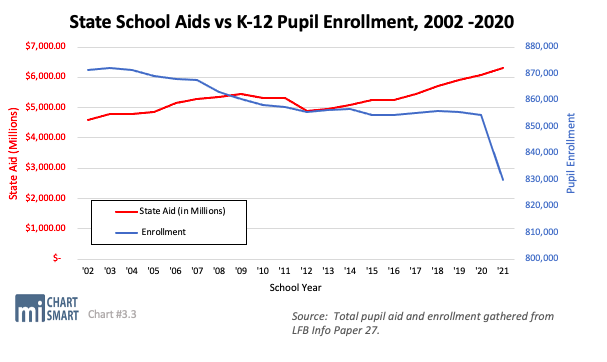
It must be noted that Milwaukee Public Schools have received about $770 million in federal COVID aid over the past nearly two years in order to avoid such a drastic decline in test scores and proficiency from occurring.
Madison Metropolitan School District followed a similar trend. In 2020-2021, 14.8% of students were proficient in ELA — a 45.8% decrease from 2018-2019, and 13.2% of students were proficient in math — a 50.9% decrease from 2018-2019.
Traditional public schools were not the only ones rocked by low proficiency scores. As a percentage of total students enrolled in the choice program, 62% of students tested at basic or below basic for math, 12% were proficient in math, and only 2% were advanced. ELA proficiency was slightly higher with 57% testing at basic or below, 16% proficient, and again only 2% advanced. These numbers are down from the 2018-2019 school year when 19% of choice students were proficient in ELA and 16% were proficient in math.
Similar to public schools, there was a high percentage of choice students who did not take the proficiency exam in 2021. 6,765 choice students, or 25% of students, did not take the ELA or math test. When these students are factored out of the equation, proficiency scores rise slightly to 14% for math and 18% for ELA. An additional 3% of students were advanced in ELA and 2% were advanced in math.
In 2021, the ACT composite score for students taking the exam was 19.1 out of a potential 36 points, down from 19.6 in 2019.
In addition to the Forward Exam, eleventh-grade students are required to take the ACT exam. The composite score for students taking the exam in 2021 was 19.1 out of a potential 36 points, compared to 19.6 in 2019. Participation was down slightly with 59,464 students taking the exam in 2019 and 56,077 taking the exam in 2021.
Breaking the data down by test subject, in 2019 the average test score for ELA was 18.0, while in 2021 it dropped slightly to 17.9. For math, scores were similar with 19.4 as the average in 2019 and 19.1 as the average in 2021.
In response to the dismal scores, Chair of the Assembly Committee on Education Representative Thiesfeldt (R- Fond du Lac) said “The scores in Wisconsin, particularly in ELA, have been dropping for years. Our education establishment, specifically DPI, has been unwilling to address the root cause of this, which is poor reading methodology. Rather than make changes along what the science tells us, they have continued to double down on poor methodology and just throw money at the problem. And continue to say they need more.”
Chair of the Senate Committee on Education, Senator Darling (R- River Hills) also called attention to this issue saying, “Our state is facing an educational crisis. We have a reading crisis and a learning crisis and the only solution coming from Governor Evers and DPI is to study it some more. I’m sick of studies. The shelves at DPI are stacked with studies. It’s time for action. Sadly, every bold initiative we have proposed over the last couple of years has been met with strong opposition to protect the status quo. Our kids deserve better and I’m not giving up on them.”
The problem with low literacy rates is nothing new in Wisconsin. Yet even after pumping billions of dollars into the K12 education system, scores still remain abysmal. This is a huge problem that should not and cannot be ignored or dismissed. Parents and taxpayers need to stand up, speak out and demand better of our children, our teachers, our administrators, and our elected officials. Our children are depending on us to fix K12 education.
Keep an eye on the MacIver Institute as we await the Department of Public Instruction’s next data release of the school report cards.




